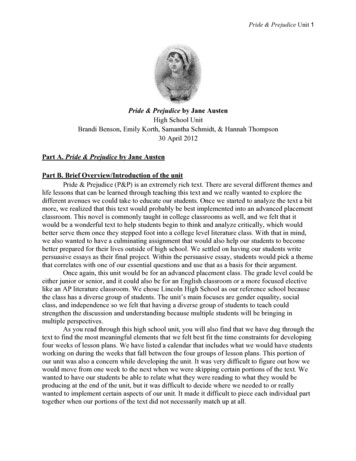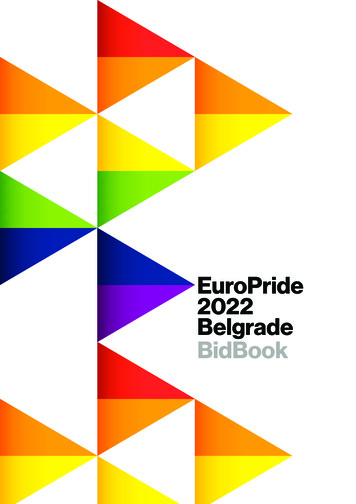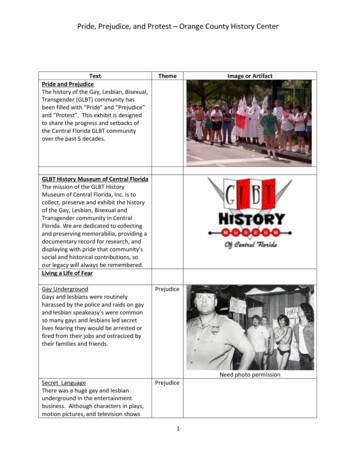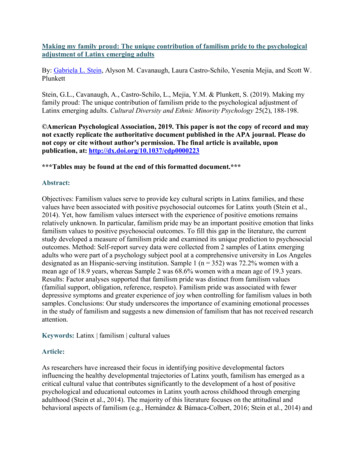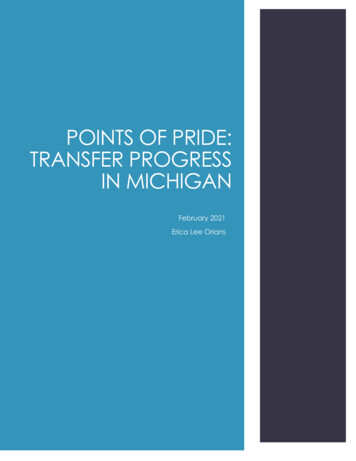
Transcription
POINTS OF PRIDE:TRANSFER PROGRESSIN MICHIGANFebruary 2021Erica Lee Orians
ContentsAbout the MCSS . 2Acknowledgements . 2Executive Summary . 3Our Collective Priorities . 4Michigan Transfer Network . 4MiTransfer Pathways . 6Points of Pride . 9Point #1: Equitable Access to Transfer Opportunities .10Point #2: Simplified Course Selection and “Light the Fire” Courses .12Point #3: Aligned Mathematics .14Point #4: Engagement Within the College .16Point #5: Relationships Between Institutions .17Point #6: Data-Informed Decision Making .18Continuing our Progress .211 Page
About the MCSSThis publication was released by the Michigan Center for Student Success at theMichigan Community College Association. The Michigan Center for Student Successwas created in 2011 with the vision of providing state-level support to Michigan’s 28community colleges by serving as a hub connecting leadership, administrators, faculty,and staff in their emerging and ongoing efforts to improve equitable student outcomes,emphasizing linkages between practice, research, and policy. More details about ourvision, values, and strategies along with information about MCSS initiatives, resources,partners, events, and other publications are available on the MCCA website atwww.mcca.org.AcknowledgementsThis transformative work would not have been possible without the one-time stateappropriation from the state of Michigan or without the partnership of our colleagues atthe Michigan Association of State Universities including Dan Hurley, Bob Murphy, andWill Emerson, the Michigan Independent Colleges and Universities including RobertLeFevre, Colby Cesaro, and Shannon Dunivon and our colleagues at the MichiganCommunity College Association including Mike Hansen and Erin Schor. The leadershipof the Transfer Steering Committee and members of the working groups that guidedvarious aspects of the work were instrumental in the design and execution of bothprojects. Improving transfer student outcomes is a priority for the presidents and chiefacademic officers at Michigan’s community colleges and their engagementthroughout this work and support of their faculty and staff to participate in this project isappreciated. Our colleagues across the nation at the National Student Clearinghouse,the Community College Research Center, SOVA, Jobs for the Future, the Dana Center,and the Aspen Institute have been national leaders in elevating the importance oftransfer students and providing excellent research, advice and guidance as well as ourcolleagues in the Student Success Center Network and especially Ken Klucznik inConnecticut. Finally, the Kresge Foundation has been a consistent supporter of theMichigan Center for Student Success and their investment in our work has beeninvaluable.Thank you to Jenny Schanker, Katie Giardello, and Donna Petras at the MichiganCenter for Student Success for their input on this report and their leadership and supportof the Michigan Transfer Network and the MiTransfer Pathways.2 Page
Executive SummaryThe Michigan Center for Student Success worked with partners across the state ofMichigan to replace the Michigan Transfer Network and develop the MiTransferPathways. This report reviews the features of the Michigan Transfer Network atwww.mitransfer.org and describes the MiTransfer Pathways which are multi-institutionalarticulation agreements that provide a clear pathway from the associate degree to thebachelor’s degree in ten programs including Art, Biology, Business, Criminal Justice,Communication, Exercise Science, Mechanical Engineering, Psychology, Public Health,and Social Work.While the Michigan Transfer Network and the MiTransfer Pathways are tangibleexamples of the progress in Michigan, there are a number of outcomes of ourcollective work which we believe are important points of pride. This report features six ofthese points of pride.Point #1: Equitable Access to Transfer OpportunitiesWith 28 community colleges and 30 universities participating in the MiTransfer Pathways,students have more equitable access to transfer opportunities in Michigan.Point #2: Simplified Course Selection and “Light the Fire” CoursesThe identification of common courses that transfer to all participating universitiesprovides students with simplified course selection and more meaningful experiences infoundational courses.Point #3: Aligned MathematicsCombined with other mathematics-specific initiatives, each program identified arecommended mathematics pathway course – quantitative reasoning, statistics, orpathway to calculus/college algebra – aligned with the program of study.Point #4: Engagement Within the CollegeThe MiTransfer project helped identify opportunities to close gaps in institutionalpractices and supported enhanced communication between faculty, staff, andadministrators at community colleges.Point #5: Relationships Between InstitutionsWith over 60 institutions involved in the statewide transfer work, community collegescultivated more meaningful relationships with peers at institutions across the state.Point #6: Data-Informed Decision MakingThe Michigan Transfer Network provides valuable data analysis tools available to allsecure users to make better transfer policy decisions.The report closes with a focus on how the MCSS plans to continue this work inpartnership with Michigan’s 28 community colleges.3 Page
Our Collective PrioritiesAccording to the National Student Clearinghouse, 52% of students who earned abachelor’s degree in Michigan in 2015-16 previously earned credit from a communitycollege. To better serve a growing cohort of transfer students, Michigan needed toinvest in providing students with better resources.The Michigan Community College Association (MCCA), with the leadership of theMichigan Center for Student Success (MCSS), partnered with the Michigan Associationof State Universities (MASU), the Michigan Independent Colleges and Universities(MICU), and the Michigan Association of Collegiate Registrars and Admissions Officers(MACRAO)to lead two historic projects in Michigan designed to better serve transferstudents.The four organizations formed the Transfer Steering Committee in 2016 with a focus onincreasing associate and bachelor’s degree completion among transfer students fromall backgrounds. Theobjective was to make theoverall transfer experienceOUR OBJECTIVE IS TO MAKE THE OVERALLmore efficient, easy toTRANSFER EXPERIENCE MORE EFFICIENT, EASYunderstand, and simple tonavigate while optimizingTO UNDERSTAND, AND SIMPLE TO NAVIGATEcredit transfer.WHILE OPTIMIZING CREDIT TRANSFER.This project was supportedby a one-time stateappropriation grant in Fall 2017. With these resources from the state of Michigan, anenhanced Michigan Transfer Network website was launched in Spring 2019 and tennew transfer agreements, the MiTransfer Pathways, were launched in 2019 and 2020.Michigan Transfer NetworkMichigan’s first statewide effort to create a centralized repository for transfer creditequivalencies was led by MACRAO in 2007-2008. The primary purpose of the site was toprovide a centralized repository to view credit equivalencies. It was an award-winningsite that provided valuable information for over 10 years.Beginning in 2014, it was clear to stakeholders that it was time to replace the site.Michigan explored several options to replace the website and ultimately choose towork with a local developer to build a custom website that would meet the needs ofour unique state. Development began in 2018 and the new website launched in May2019.4 Page
The enhanced Michigan TransferNetwork delivers on the promise toprovide students with transferinformation that is easy tounderstand and simple tonavigate. A one-minute videoprovides visitors to the site with aquick overview of all of theresources available.Students can search for courseequivalencies in the databasethat includes more than 1.5 millionequivalencies. Expanded searchfeatures allow students to searchfor courses by sending or receivinginstitution or search by coursesubject and number. In addition,students can download resultsand save to their device.FIGURE 1: MICHIGAN TRANSFER NETWORKStudents can also locate information about the Michigan Transfer Agreement (MTA),Michigan’s general education transfer agreement and locate articulation agreementsand transfer guides. Information is also available for high school students, studentstransferring from outside Michigan, and military-connected students.One of the most popular features on the website are the institutional profile pageslinked from Find Colleges & Universities. Students can review a map of the state ofMichigan to locate a community college and find detailed transfer information. Anexample from Schoolcraft College (Figure 2) demonstrates that the MTN is more thanjust course equivalencies. Students can find information about transcripts, campusresources, and details about earning academic credit for prior learning through variousforms of alternative credit.5 Page
FIGURE 2: INSTITUTIONAL PROFILE PAGE EXAMPLE FORSCHOOLCRAFT COLLEGEEach institution in Michiganhas a customized profilepage. Information on thispage is provided andmaintained by the institutionand links directly toinformation on the college’swebsite. The MTN serves asan aggregator of resourcesacross institutions. Theseresources contribute to Pointof Pride #1: Equitable Accessto Transfer Opportunities. Inaddition to providing helpfulinformation to students, theseresources have alsogenerated opportunities forcommunity colleges to shareideas. This type of crosscollege engagement isdescribed in more detail inPoint of Pride #5:Relationships BetweenInstitutions.The MTN provides tremendously valuable information for students, but the leadershipwho designed the site also saw an opportunity to improve the “backend” of thewebsite. As described in Point of Pride #6: Data-Informed Decision Making, the securearea of the website provides administrators and faculty at community colleges withinvaluable information to improve the transfer experience for students.MiTransfer PathwaysAll 28 Michigan community colleges signed the Michigan Transfer Agreement (MTA) in2014 along with public universities and independent institutions in Michigan. The MTA isMichigan’s general education block transfer agreement and it includes 30 credit hoursin five distribution areas. Community colleges have been anxious to expand thisstatewide agreement with the goal of transferring the entire associate degree. Toachieve this goal, we created the MiTransfer Pathways which were designed as multiinstitutional associate to bachelor’s degree transfer agreements including multiplecommunity colleges and multiple universities. Students can complete an associatedegree at a participating community college that includes the MTA and selectedprogram specific MiTransfer Pathways courses before transferring to a participatinguniversity.6 Page
Figure 3 illustrates the conceptual model for the MiTransfer Pathways agreements. Withthis model, students can complete the MTA, major-specific courses that will transfer andapply to every participating university, and electives/other courses that are required bythe community college or some, but not all, participating universities. Once studentsearn the associate degree, they can transfer to a participating university to completethe remaining bachelor’s degree requirements.FIGURE 3: MITRANSFER PATHWAYS CONCEPTUAL MODELEngaging in this collective work has significant benefits for participating communitycolleges and their students. The process simplified course selection because facultyidentified courses that were common across the curriculum which is described in moredetail in Point of Pride #2: Simplified Course Selection and “Light the Fire” Courses.Faculty also spent time identifying the appropriate mathematics course aligned withtheir program from the MTA mathematics distribution area. More details about thisprocess are highlighted in Point of Pride #3: Aligned Mathematics. The impact of theseconvenings are discussed in more detail in Point of Pride #5: Relationships BetweenInstitutions.7 Page
Once agreements were signed, community colleges were encouraged to use thisinformation to create web-based or print resources about the MiTransfer Pathways forstudents and to train advisors and counselors, faculty, admissions officers, and otheradministrators on the pathways. Figure 4 displays an example of how St. Clair CountyCommunity College shares information about the MiTransfer Pathways with students ontheir website. TheCollege participatesin eight transferpathways andinformation abouteach pathway isavailable by clickingthe symbol besideeach pathway.Students can seewhat courses arerequired in thepathways and whichuniversities areparticipating in thepathway. ThisFIGURE 4: MITRANSFER PATHWAYS WEBSITE EXAMPLE FROMinformation isST. CLAIR COUNTY COMMUNITY COLLEGEavailable with links to othertransfer information such as the Michigan Transfer Agreement, articulation agreements,their University Center, reverse transfer, transferring to SC4, and other helpful resourcesfor students.8 Page
Points of PrideWhile the new Michigan Transfer Network and the tenMiTransfer Pathways agreements are tangible examples ofour progress toward improving transfer student outcomes,they don’t completely reflect the significant progressMichigan’s community colleges have made through thiscollective work. To understand these intangible outcomes,we are featuring six points of pride. Each point of pridedescribes one aspect of our transfer work that has had asignificant benefit to community colleges in Michigan.Point #1: Equitable Access to Transfer OpportunitiesWith 28 community colleges and 30 universities participatingin the MiTransfer Pathways, students have more equitableaccess to transfer opportunities.Point #2: Simplified Course Selection and “Light the Fire”CoursesThe identification of common courses that transfer to allparticipating universities provides students with simplifiedcourse selection and more meaningful experiences infoundational courses.Point #3: Aligned MathematicsCombined with other mathematics related initiatives, eachMiTransfer Pathways selected a recommended mathematicspathway – quantitative reasoning, statistics, or pathway tocalculus/college algebra – aligned with the program.Point #4: Engagement Within the CollegeThe MiTransfer project identified gaps in institutional practicesand supported enhanced communication between faculty,staff, and administrators at community colleges.Point #5: Relationships Between InstitutionsWith over 50 institutions involved in the statewide transferwork, community colleges created more meaningfulrelationships with peers at institutions across the state.Point #6: Data-Informed Decision MakingThe Michigan Transfer Network provides valuable dataanalysis tools available to all secure users to make bettertransfer decisions.9 Page
Point #1: Equitable Access to Transfer OpportunitiesIn Michigan, there is not a state agency or executive office for higher education tomanage statewide transfer efforts. Michigan does not have a common coursenumbering system, there are no common learning outcomes across institutions, andthere were previously no state level coordinated articulation agreements,Despite this lack of coordination, transfer students are mobile between and amongcolleges and universities throughout the state. Figure 5 illustrates the various transferpatterns from Michigan community colleges to public and independent institutionsacross the state.1FIGURE 5: TRANSFER PATTERNS FROM COMMUNITY COLLEGES TO UNIVERSITIES IN MICHIGANFor instance, Gogebic Community College is located in Michigan’s far western UpperPeninsula and has the smallest enrollment in the state (student headcount was 1,188 in2018-2019). Despite a small student population, students from Gogebic transferred to 9public universities, 2 independent colleges, several in-state community colleges, andFigure 5 is from an analysis published in Postsecondary Transfer and Mobility in Michigan:Exploring Transfer Patterns, Programs, Places, and People by Jason Taylor, Ph.D. available 0 P a g e
also to out-of-state institutions in the 2018-19 academic year (Source:www.mischooldata.org). As a participant in all 10 MiTransfer Pathways agreements,Gogebic Community College can offer students the same transfer options ascommunity colleges with much larger student populations in closer geographicproximity to transfer partners, creating greater equity in access across the state.In another example, Wayne County Community College District (WCCCD) located inDetroit, Michigan enrolls about 33% of the total Black and African-American students atcommunity colleges in Michigan (Source: IPEDS). Although WCCCD is located in adensely populated area with many transfer options available to students, the collegeparticipated in all 10 MiTransfer Pathways agreements so that their students canmaximize transfer opportunities with nearby partners or colleges and universities acrossthe state. WCCCD continues to participate in transfer initiatives to achieve its strategicgoal to strengthen partnerships with 4-year colleges and universities. WCCCD’s largesttransfer partner is Wayne State University (WSU) with nearly 500 students transferring fromWCCCD to WSU in 2018-19, yet WCCCD students transfer to all 15 public universities inMichigan, a dozen independent colleges and universities, and several communitycolleges. Given the high number of transfer destinations of WCCCD students, theMiTransfer Pathways created opportunities for WCCCD to offer more transferrablecourses and establish relationships with more transfer partners across the state.At Kalamazoo Valley Community College (KVCC) located in Kalamazoo, Michigan,nearly 75% of KVCC students transfer to Western Michigan University (WMU), alsolocated in Kalamazoo (Source: www.mischooldata.org). But because KVCCparticipates in eight of the pathways, the college offers students transfer opportunitiesat institutions across the state and also works actively with WMU’s one MiTransferPathway in Business.These are just three examples of the impact of the MiTransfer Pathways on expandingequitable access to transfer opportunities in Michigan. The Transfer Steering Committeeselected 12 programs for which to create MiTransfer Pathways agreements. These 12programs represent some of largest bachelor’s degree programs in the state based oncompletion data in IPEDS, have strong labor market outcomes or represent programswith the greatest need for more graduates based on information from Michigan’sBureau of Labor Market Information and Strategic Initiatives (Source:https://bit.ly/2LVBIcu). We successfully developed 10 MiTransfer Pathways agreementsin Art, Biology, Business, Communication, Criminal Justice, Exercise Science, MechanicalEngineering, Psychology, Public Health, and Social Work.2We have enjoyed widespread participation in the MiTransfer Pathways. All 28community colleges participated in the MiTransfer Pathways initiative and 14community colleges participate in all 10 pathways agreements. These agreementscollectively potentially replace 3,571 individual articulation agreements between oneWe convened faculty in Computer Science and English but were unable to come to consensuson common courses within the time limits of this funded project.211 P a g e
community college and one university. Each pathway included between three andten courses that are all required by the bachelor’s degree granting institution, applytransfer credit toward the major and are documented as direct transfer equivalenciesin the Michigan Transfer Network. Figure 6 displays the number of participatinginstitutions in each pathway.FIGURE 6: MITRANSFER PATHWAYS PARTICIPATIONTo be sure, community colleges had relationships with multiple transfer partners prior tothe MiTransfer Pathways, but these multi-institutional agreements provided aconvenient way to establish partnerships with institutions across the state. While nearbytransfer partners will always be important, the expansion of completely online programsdue to the Coronavirus pandemic offers students more choices and more flexibility intheir transfer destination.Point #2: Simplified Course Selection and “Light the Fire”CoursesStudents are frequently faced with making high-stakes decisions regarding whichcourses to take early in their academic career. Too often, students are presented witha complicated matrix of choices which could lead to wasted credits and repeatedcontent, particularly as transfer destinations are often inconsistent in how they take thesame community college’s coursework.The MiTransfer Pathways project addressed this issue by engaging faculty in a processof selecting courses that are required, recommended, optional and appropriate forstudents to complete in the first- and second-year at the community college.12 P a g e
Faculty participated in a relatively quickprocess to identify these courses duringstatewide convenings. Large easel-padsheets were placed around the roomwith common lower division coursesidentified. Faculty were provided with asheet of stickers with the name of theirinstitution on the label. University facultyplaced their sticker in the “yes” columnif the course is required, recommended,optional or appropriate in the first- andsecond-year of the program.Community college faculty placed alabel in the “yes” column if the course isoffered at the community college. Theexample in Figure 7 is an example of theprocess and shows that GeneralChemistry I is required, recommended,optional, or appropriate in the Biologyprograms at every participatinguniversity and it is offered at everyFIGURE 7: MITRANSFER PATHWAYS COURSE POSTER community college. Faculty engagedEXAMPLEin this process for 10-15 courses perpathway. The “sticker” process tookabout 15-20 minutes to complete, leaving the faculty time to discuss the common lowerdivision courses in the pathway. Ultimately, each program identified between threeand ten courses that should be completed in the first- and second- year at thecommunity college. With only a few exceptions, these common courses will transfer toall of the four-year institutions participating in the MiTransfer Pathways agreements. Forexample, the Psychology faculty recommended that students complete Introduction toPsychology, Abnormal Psychology, Life Span/ Developmental Psychology, and SocialPsychology. These MiTransfer Pathways courses, along with the Michigan TransferAgreement courses, will transfer and apply in the Psychology program at all 20participating universities. In addition, participating universities identified othertransferrable courses specific to their institution but not universally required orrecommended at all participatinginstitutions that could be completed atparticipating community colleges. Thecommunity colleges also identifiedPSYCHOLOGY MITRANSFER PATHWAYScourses that are required for theCOURSESassociate degree but may not beIntroduction to PsychologyAbnormal Psychologyrequired for the bachelor’s degree.Life Span/ Developmental PsychologyOnce faculty identified these commonSocial Psychologycourses, institutions began a process to13 P a g e
ensure that all of the MiTransfer Pathways courses transferred as direct equivalents (i.e.PSY 101 PSYCH 111) instead of general, departmental, or elective credit (i.e. PSY 101 PSYCH GEN) and that the equivalent courses were published in the course equivalencydatabase on the Michigan Transfer Network.These common MiTransfer Pathways courses have several benefits. Counselors andadvisors can help students make simplified course selections. It is not necessary tocheck and double-check that a particular course transfers to the students’ transferdestination. In addition, common courses across all participating colleges anduniversities prevent students from having to make a high-stakes decision about atransfer destination early in their academic program. Since the Michigan TransferAgreement and the MiTransfer Pathways courses will transfer to participatinguniversities, students can take the first-year, or more, to explore transfer destinations.There are also benefits to the community college. Along with their peers across thecountry, community colleges throughout Michigan have been implementing GuidedPathways, an institution-wide reform effort aimed at providing students with clearguidance and integrated supports to improve completion and transfer. The GuidedPathways model encourages colleges to shift course selection from a broad a la-cartemodel to supporting students in selecting courses aligned with their academic programor strategic exploration of programs. The identification of MiTransfer Pathways coursessupports this strategic course selection process by identifying foundational courses andensuring they will transfer to related bachelor’s degree programs.Community colleges can focus their attention on offering high-quality educationalexperiences to students in the MiTransfer Pathways courses. Davis Jenkins, SeniorResearch Scholar at the Community College Research Center at Teachers College,Columbia University notes that community colleges should focus on offering “light thefire” learning experiences to students in the foundational courses in the discipline. TheMiTransfer Pathways courses allow colleges to focus attention on foundationalprogram-specific courses and to transform these courses from a basic introduction tothe discipline to an engaging learning experience where students are oriented to thediscipline, learn how to learn, are provided the opportunity to engage in research orapply and deepen knowledge and skills through projects, internships, co-ops, clinicalplacements, group projects outside of class, service learning, study abroad and otheractive learning activities.Point #3: Aligned MathematicsMathematics is far too often a significant barrier to completion, and Michigan’scommunity colleges have engaged in several projects to improve student success inmathematics. The MCSS convened the Right Math @ the Right Time (RM@RT) SteeringCommittee to lead much of this work. The RM@RT included mathematics faculty,executive leadership, registrars, and advisors from community colleges and universities.When Michigan adopted the Michigan Transfer Agreement in 2014, the MTAestablished three math pathways in Quantitative Reasoning, Statistics, and the Pathway14 P a g e
to Calculus/College Algebra. Michigan was selected to participate in the Charles A.Dana Center’s Math Pathways to Completion project which further defined thelearning outcomes for each of the MTA mathematics pathways.Aligning the “right” math pathway with each MiTransfer Pathway program was a priorityfor community colleges. Too often, student’s default into taking a course on thepathway to calculus/college algebra because it is perceived as the most flexiblechoice among the three math pathways. However, students who have selected aprogram don’t need flexible choices and should, instead, select an MTA mathematicscourse that is best suited to their program of study.Through the MiTransfer Pathways project, in addition to asking faculty to select requiredand recommended courses to complete in the first and second year, we asked facultyto select the appropriate mathematics pathway for their program. During thestatewide MiTransfer convenings, a mathematics faculty member joined each of theprogram faculty groups to discuss the three mathematics options and recommend thebest pathway for their programs. In some cases, any MTA mathematics course issufficient, but the process of identifying specific mathematics courses help studentsmake an appropriate mathematics pathway choice.PathwayArtBiologyMTA MathematicsQuantitative ReasoningPathway to Calculus/College e Reasoningor StatisticsCriminal JusticeAny PathwayExercise SciencePathway to CalculusMechanical Engineering Pathway to CalculusPsychologyStatisticsPublic HealthStatisticsSocial WorkStatisticsFigure 8: MiTransfer Pathways Mathematics RecommendationsSupporting student success in mathematics continues to be a priority for Michigancommunity colleges. Following its MiTransfer Pathways work, the MCSS launched theMiStart2Finish initiative which focuses on ensuring that students, even under-preparedstudents, can complete the MTA mathematics requirement in the first year ofenrollment. This project focuses specifically on addressing inequalities by race andethnicity, age, and college-readiness by helping colleges analyze disaggregated dat
new transfer agreements, the MiTransfer Pathways, were launched in 2019 and 2020. Michigan Transfer Network Michigan's first statewide effort to create a centralized repository for transfer credit equivalencies was led by MACRAO in 2007-2008. The primary purpose of the site was to provide a centralized repository to view credit equivalencies.
